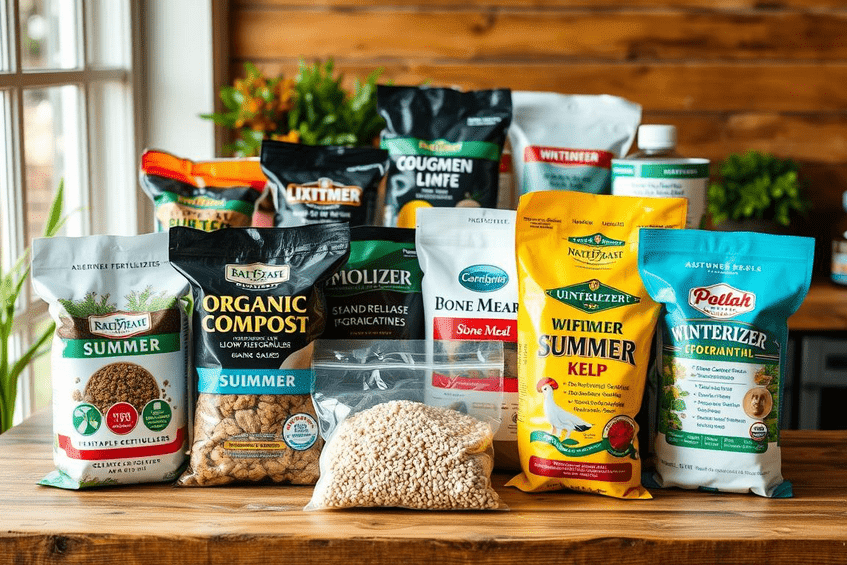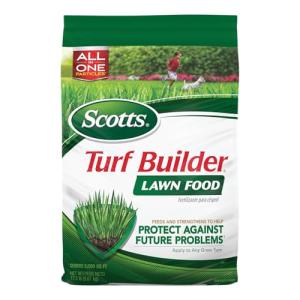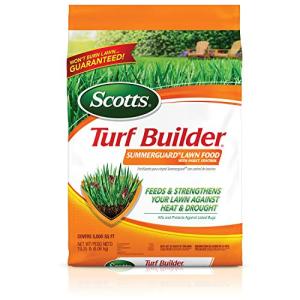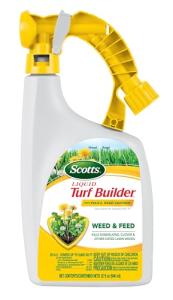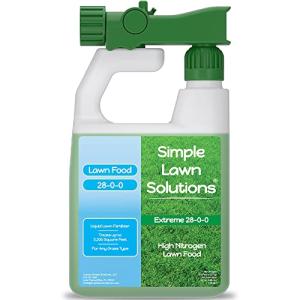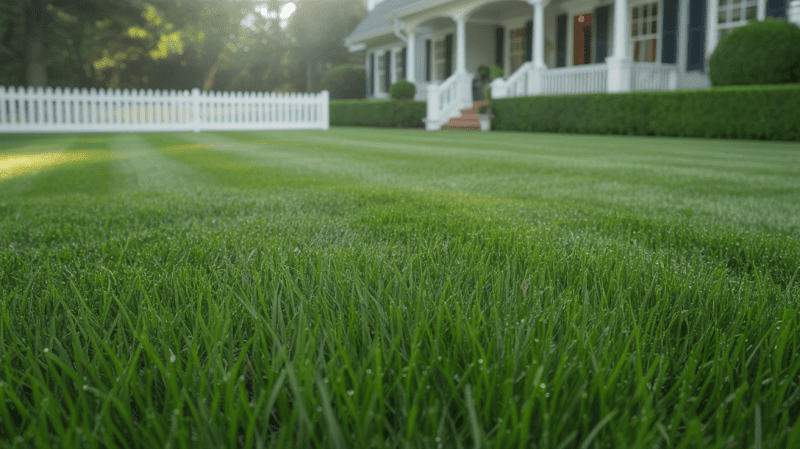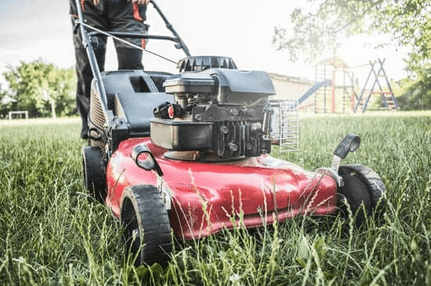Seasonal Fertilizer Guide: What to Use When
As a seasoned gardener, I know how challenging it is to maintain a healthy lawn. A lush lawn results from smart, consistent care throughout the year. The right fertilizers at the right time are key for growth and garden success.

In this guide, I'll share my knowledge on best fertilizer application techniques and nutrient-rich fertilizers for each season. Follow this guide to give your garden the nutrients it needs to thrive.
Key Takeaways
- Understand the importance of seasonal fertilization
- Learn the best fertilizer application techniques
- Discover nutrient-rich fertilizers for your garden
- Get tips on maintaining a healthy lawn year-round
- Maximize your garden's potential with smart fertilization
Understanding the Seasonal Fertilizer Cycle
A lush garden starts with knowing the seasonal fertilizer cycle. It's key to understand how seasons change your lawn's needs.
Why Timing Matters in Fertilizer Application
Timing is everything when you fertilize your lawn. The right time ensures your grass gets the nutrients it needs. Proper timing also stops over-fertilizing, which can harm your lawn and the environment.
Applying spring fertilizer too early can cause excessive growth. This makes your lawn more open to disease and pests. Waiting too long in the season can leave your lawn vulnerable to winter.
The Connection Between Plant Growth Cycles and Nutrient Needs
Plants need different nutrients at different growth stages. Knowing these needs is key for good fertilizer use. For example, spring plants need more nitrogen for leaves. Fall plants require phosphorus and potassium for healthy root growth.
Matching your fertilizer to your plants' growth cycles ensures they get the right nutrients. This promotes healthy growth and development.
Best Fertilizers for Every Season: My Complete Guide
As the seasons change, your lawn's fertilizer needs change too. It's essential to adjust your fertilization strategy for optimal results. This keeps your lawn healthy and thriving all year round.
How Seasonal Changes Affect Plant Nutrition Requirements
Different seasons mean different temperatures, moisture levels, and growth rates. These changes affect your lawn's nutritional needs. For example, in spring, your lawn needs more nitrogen for growth. In the fall, it requires phosphorus and potassium for root development and winter preparation.

Matching Fertilizer Types to Seasonal Plant Needs
Choosing the right fertilizer is key. Slow-release fertilizers are great for summer because they provide nutrients steadily. Quick-release fertilizers are better in spring for a quick growth boost.
Organic vs. Synthetic Options Throughout the Year
Both organic and synthetic fertilizers have their uses. Organic options, such as compost or manure, release nutrients slowly and improve soil health. Synthetic fertilizers give a quick nutrient boost. Your choice depends on your lawn's needs and your preference.
Reading Fertilizer Labels: NPK Ratios Explained
Understanding NPK ratios on fertilizer labels is important. The numbers show the percentages of nitrogen (N), phosphorus (P), and potassium (K). For example, a 10-10-10 ratio is balanced for general use. A 20-5-5 ratio is high in nitrogen, great for spring leaf growth.
Spring Fertilizers: Awakening Your Garden
As winter fades, it's time to wake up your garden with the right spring fertilizers. Early spring is the best time to fertilize. This is when your grass starts growing, usually from late March to early May.

Early Spring Starter Fertilizers
Early spring starter fertilizers are key for starting your lawn's growth. They have a balanced mix of nutrients for new growth.
Top Products for Lawn Wake-Up
For a lawn wake-up, look for fertilizers with lots of phosphorus. This helps roots grow. Miracle-Gro Shake 'n Feed and Scotts Turf Builder are good examples.
Garden Bed Preparation Formulas
For garden beds, use a balanced fertilizer with nitrogen, phosphorus, and potassium. Espoma Organic Bloom! is a favorite among gardeners.
Nitrogen-Rich Options for Leafy Growth
Nitrogen-rich fertilizers are key for leafy growth in spring. They help your plants grow lush and green.
Best Organic Choices for Spring Gardens
Organic fertilizers are great for spring gardens. They release nutrients slowly, thereby improving soil health. Compost, fish emulsion, and bone meal are top choices.
| Fertilizer Type | N-P-K Ratio | Application Rate |
|---|---|---|
| Compost | 1-1-1 | 2-4 inches |
| Fish Emulsion | 5-1-1 | 1-2 tablespoons/gallon |
| Bone Meal | 3-15-0 | 1-2 cups/100 sq ft |
Application Techniques for Maximum Spring Effectiveness
To get the most from spring fertilizers, follow the right application techniques. Apply at the right time, use the correct amount, and ensure even coverage.
By doing this, you'll give your lawn a strong start to the growing season. It will grow vibrant and healthy all spring.
Summer Fertilizers: Supporting Growth During Heat
Summer can be tough on lawns, but the right fertilizer can make a significant difference. High temperatures, drought, and increased foot traffic on the lawn are common problems. Fertilizing now can help keep your lawn healthy and looking its best all summer.
Slow-Release Formulations for Summer Longevity
Slow-release fertilizers are great for summer. They provide your lawn with nutrients gradually over time. This helps it better deal with heat and dryness. Select fertilizers with a balanced or slightly higher nitrogen content to help your lawn thrive.
Water-Soluble Options for Quick Nutrient Delivery
Water-soluble fertilizers give your lawn a quick nutrient boost. This is beneficial for times when your lawn is growing rapidly or experiencing stress. They work quickly but may need to be applied more frequently.
Specialized Fertilizers for Flowering and Fruiting Plants
For gardens with plants that bloom or produce fruit, specialized fertilizers can be beneficial. These fertilizers have more phosphorus to help plants bloom and produce fruit. Using the right fertilizer can significantly enhance your plants' performance in the summer.
Drought-Resistant Fertilizing Strategies
Drought-resistant fertilizing helps your lawn hold onto water better. Organic matter and certain micronutrients are key in making your lawn more drought-tolerant. Adding these to your fertilizing routine can help your lawn stay healthy, even when it's very hot.
Fall Fertilizers: Preparing for Dormancy
As the seasons change, it's crucial to prepare your lawn for dormancy with the right fall fertilizers. This preparation is key to ensuring your lawn remains healthy throughout the winter months and is ready to flourish again in the spring.
Phosphorus and Potassium-Rich Formulas for Root Development
In early fall, your lawn needs fertilizers that support root development. Phosphorus-rich fertilizers are ideal for this purpose, as they promote healthy root growth and development. Also, potassium-rich fertilizers help improve the overall resilience of your lawn, making it more resistant to disease and harsh winter conditions.
"Using the right fertilizers at the right time is crucial for lawn health," says a renowned gardening expert. "Phosphorus and potassium are essential nutrients that help lawns withstand the cold weather."
Lawn Winterizing Products
Lawn winterizing products are specially designed to provide your lawn with the necessary nutrients to survive the winter. These products often contain a mix of phosphorus, potassium, and other micronutrients that help strengthen your lawn.
- Look for products with a balanced NPK ratio.
- Choose products that are specially labeled as "winterizing" or "fall application."
Compost and Organic Matter Applications
In addition to synthetic fertilizers, applying compost and organic matter can significantly benefit your lawn. Compost adds essential nutrients to the soil, enhances soil structure, and promotes beneficial microbial activity.
Timing Your Fall Fertilizer Applications
Timing is everything when it comes to applying fall fertilizers. Early fall, around September or early October, is typically the best time. This timing supports root development before the winter dormancy sets in.
By applying the right fall fertilizers at the right time, you can ensure your lawn is well-prepared for the winter months and will be healthy and vibrant when spring arrives.
Winter Fertilizing: Maintaining Plants During Cold Months
I recommend adjusting your fertilizing schedule for winter. Some plants need nutrients even when they're dormant. This helps them survive the cold.
Indoor Plant Nutrition During Winter
Indoor plants face challenges in winter. The air is dry, and light is scarce. Use a balanced, water-soluble fertilizer at half strength. This keeps them nourished without harm.
Greenhouse Fertilizing Strategies
Greenhouse plants grow differently than outdoor ones. They need a steady nutrient supply. A slow-release fertilizer is perfect for this, supporting their growth.
Preparing for Early Spring with Late Winter Applications
Late winter is the perfect time to get your garden ready for spring. Use a phosphorus-rich fertilizer to boost root growth. This gives your plants a strong start in the new season.
| Fertilizer Type | Application Time | Benefits |
|---|---|---|
| Balanced, water-soluble | Throughout winter | Maintains indoor plant health |
| Slow-release | Winter | Promotes steady growth in greenhouses |
| Phosphorus-rich | Late winter | Encourages root development for spring |
"The best time to plant a tree was 20 years ago. The second-best time is now." Adjusting your fertilizing for winter is crucial. It ensures your plants thrive in spring.
"The garden is a love song, a duet between a human being and Mother Nature."
Conclusion
Following this seasonal fertilizer guide helps your garden receive the best care throughout the year. We've seen how each season needs different fertilizers for healthy growth. This ensures your plants thrive.
It's essential to use the correct fertilizers at the optimal time. This keeps your lawn and garden looking great. From spring to winter, each season has its own needs. By following this guide, your outdoor space will stay lush and vibrant all year.
When planning your fertilizer schedule, consider your soil type, climate, and the specific plants you are growing. The right approach makes your garden beautiful and thriving. Enjoy the fruits of your labor and the joy of a well-cared-for garden.
FAQ
What is the best fertilizer for my lawn during the spring season?
In spring, choose a fertilizer rich in nitrogen for leafy growth. Look for a balanced fertilizer with an NPK ratio of 10-10-10. Alternatively, choose a starter fertilizer with a higher phosphorus content.
How often should I fertilize my lawn during the summer months?
Summer calls for regular lawn fertilization. Use a slow-release fertilizer to feed your lawn over time. Fertilize every 6-8 weeks, following the instructions.
What type of fertilizer should I use in the fall to prepare my lawn for winter?
Fall is the ideal time for using phosphorus- and potassium-rich fertilizers. They help your lawn grow strong roots for winter. Choose a fertilizer with an NPK ratio of 0-20-20 or a winterizing product.
Can I use synthetic fertilizers, or should I switch to organic options?
Synthetic fertilizers work fast, while organic ones build soil health. Mix both for the best results. It depends on your lawn's needs and your preferences.
How do I read fertilizer labels, and what do the NPK ratios mean?
Fertilizer labels display the NPK ratio, indicating the levels of nitrogen, phosphorus, and potassium. Knowing this helps you pick the right fertilizer for your lawn. For example, 10-10-10 means it's balanced with equal parts of each.
What are some drought-resistant fertilizing strategies for the summer?
To keep your lawn strong in summer, use slow-release fertilizer. Water deeply but less often. Also, mow and care for your soil properly. This encourages deep roots and drought resistance.
Can I fertilize my indoor plants during the winter?
Yes, fertilize indoor plants in winter, but use a balanced, water-soluble fertilizer at a lower strength. This keeps them healthy during the cold months.
How do I prepare my lawn for early spring with late winter applications?
To prepare your lawn for spring, apply a balanced or starter fertilizer with a higher phosphorus content in late winter. This provides your lawn with the necessary nutrients as it begins to grow.
DISCLAIMER
This document is provided for general information purposes only and should not be relied upon as providing legal advice, technical, or specific operational guidance to the reader, whether as to the practices described in the document or the applicable legal requirements and regulations. Lawnfly.com expressly disclaims any responsibility for liability arising from or related to the use or misuse of any information in this document.
